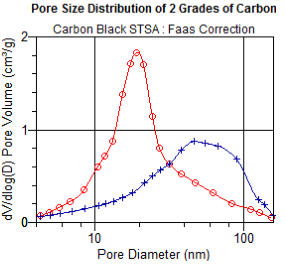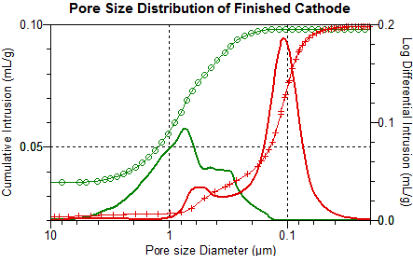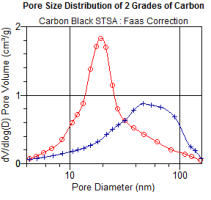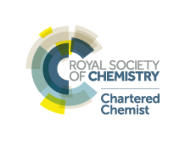




Expertise in the Physical
Characterisation of Materials

MCA Services
Unit 1A Long Barn, North End, Meldreth, Cambridgeshire SG8 6NT UK
01763 262333
© MCA Services




Our
gas
adsorption
and
mercury
porosimetry
techniques
are
applicable
to
the
investigation
of
component
materials,
such
as
carbons,
graphites
and
active
cathode
materials.
An
understanding
of
the
porous
nature
of
these
is
vital
for
determining
packing
characteristics,
electrode
conductivity
and
electrochemical
activity.
Careful
selection
of
raw
materials
having
optimum
porosity
is
often
required
so
that
a
desired balance between efficiency and cycling lifetime is achieved.
The
porous
nature
of
finished
electrodes
is
likely
to
be
different
from
the
components
materials
due
to
processing
and
additives.
However,
this
porosity
exerts
profound
influence
over
electrolyte
transport,
conductivity,
availability
of
active
reaction
sites,
mechanical
stress,
charge
/
discharge
characteristics
and
cycling
lifetime.
Mercury
porosimetry
is
ideally
suited
to
the
characterisation
of
finished
electrodes
and
can
be
extended
to
measure
the
tortuosity
of
a
pore
network,
providing
vital
information
relating
to
many
of
these
performance measures.
Mercury
porosimetry
is
also
applicable
to
the
determination
of
the
porous
structure
of
separator
materials,
where
a
tight
distribution
of
pores of a certain size is demanded for efficient transfer properties.
For
active
metal
impregnated
systems,
the
active
metal
surface
area
and
dispersion
can
be
measured
accurately
by
chemisorption
(chemical
adsorption).
MCA
Services
offers
a
range
of
adsorptive
options,
CO
and
H
2
being
commonly
applied,
and
two
techniques:
static
and dynamic (pulse) chemisorption. A wide range of active metals and metal loading s can, therefore, be characterised.
MCA
Services
offers
a
complete
suite
of
techniques
for
the
characterisation
of
porosity
with
the
experience
and
expertise
to
actively
assist
with
interpretation
of
results.
We
have
extensive
experience
in
the
characterisation
of
carbons
and
graphites
as
well
as
research
and
development
of
Li-ion
battery
technology.
Our
ongoing
in-house
research
has
focused
on
battery
and
super-capacitor
applications:
a
field
in which we have journal publications.
Key Techniques:·
BET Surface Area - by nitrogen or krypton adsorption
Micropore Analysis - pore size, area and volume distribution
Gas Adsorption - pore size, area and volume distribution in the mesopore range
Mercury Porosimetry - for pore size, pore volume & pore area distribution
Mercury Porosimetry - for cavity to throat size evaluation
Permeability and Tortuosity measurement via Mercury Porosimetry & Pycnometry
Chemisorption by a range of gases for analysis of catalysts
Density measurement - absolute density, bulk density & skeletal density
Total Pore Volume and Solid Fraction measurement
CHARACTERISATION OF BATTERY COMPONENTS
The
porous
nature
of
electrode
components,
finished
electrode
architectures
and
separator
materials
is
critical
to
the
performance
optimisation
of
battery
systems.
Pore
volume
and
pore
size
distribution
have
profound
effects
on
energy
density,
electrolyte
transport
characteristics,
electrode
conductivity,
cycling
lifetime
&
degradation
and
availability
of
active
sites
for
electrochemical
reaction.
When
electrode
materials
contain
active
metals
doped
to
a
substrate, their dispersion and surface area have a primary influence over battery performance and efficiency.
The
understanding
of
the
porosity
of
battery
components
is,
therefore,
necessary
at
all
stages
of
battery
development:
materials
selection,
production
and
failure
analysis.
Measuring
the
dispersion
and
surface
area
of
active metals by chemisorption is a valuable tool for the understanding and optimisation of battery systems.
Key Benefits:
•
Pore volume and pore size distribution characterisation
•
Tortuosity measurement for studying pore networks
•
Characterisation of component material porosity
•
Characterisation of finished electrode porosity
•
Measurement of active metal properties via chemisorption
•
Establishing process control settings for electrode manufacture
•
Characterisation of separator porosity
•
Assistance with data interpretation
•
Expansive data presentation and comparative overlay options
•
Highly experienced in catalysis and electro-catalysis








Expertise in the Physical
Characterisation of Materials
MCA Services
Unit 1A Long Barn, North End,
Meldreth, Cambridgeshire SG8 6NT UK
01763 262333
© MCA Services






01763262333
CHARACTERISATION OF BATTERY COMPONENTS
The
porous
nature
of
electrode
components,
finished
electrode
architectures
and
separator
materials
is
critical
to
the
performance
optimisation
of
battery
systems.
Pore
volume
and
pore
size
distribution
have
profound
effects
on
energy
density,
electrolyte
transport
characteristics,
electrode
conductivity,
cycling
lifetime
&
degradation
and
availability
of
active
sites
for
electrochemical
reaction.
When
electrode
materials
contain
active
metals
doped
to
a
substrate,
their
dispersion
and
surface
area
have
a
primary
influence
over
battery
performance and efficiency.
The
understanding
of
the
porosity
of
battery
components
is,
therefore,
necessary
at
all
stages
of
battery
development:
materials
selection,
production
and
failure
analysis.
Measuring
the
dispersion
and
surface
area
of
active
metals
by
chemisorption
is
a
valuable
tool
for
the
understanding and optimisation of battery systems.
Key Benefits:
•
Pore volume and pore size distribution characterisation
•
Tortuosity measurement for studying pore networks
•
Characterisation of component material porosity
•
Characterisation of finished electrode porosity
•
Measurement of active metal properties via chemisorption
•
Establishing process control settings for electrode manufacture
•
Characterisation of separator porosity
•
Assistance with data interpretation
•
Expansive data presentation and comparative overlay options
•
Highly experienced in catalysis and electro-catalysis
Our
gas
adsorption
and
mercury
porosimetry
techniques
are
applicable
to
the
investigation
of
component
materials,
such
as
carbons,
graphites
and
active
cathode
materials.
An
understanding
of
the
porous
nature
of
these
is
vital
for
determining
packing
characteristics,
electrode
conductivity
and
electrochemical
activity.
Careful
selection
of
raw
materials
having
optimum
porosity
is
often
required
so
that
a
desired
balance
between
efficiency
and
cycling
lifetime is achieved.
The
porous
nature
of
finished
electrodes
is
likely
to
be
different
from
the
components
materials
due
to
processing.
However,
this
porosity
exerts
profound
influence
over
electrolyte
transport,
conductivity,
availability
of
active
reaction
sites,
mechanical
stress,
charge
/
discharge
characteristics
and
cycling
lifetime.
Mercury
porosimetry
is
ideally
suited
to
the
characterisation
of
finished
electrodes
and
can
be
extended
to
measure
the
tortuosity
of
a
pore
network,
providing
vital
information relating to many of these performance measures.
Mercury
porosimetry
is
also
applicable
to
the
determination
of
the
porous
structure
of
separator
materials,
where
a
tight
distribution
of
pores of a certain size is demanded for efficient transfer properties.
For
active
metal
impregnated
systems,
the
active
metal
surface
area
and
dispersion
can
be
measured
accurately
by
chemisorption
(chemical
adsorption).
MCA
Services
offers
a
range
of
adsorptive
options,
CO
and
H
2
being
commonly
applied,
and
two
techniques:
static
and
dynamic
(pulse)
chemisorption.
A
wide
range
of
active
metals and metal loading s can, therefore, be characterised.
MCA
Services
offers
a
complete
suite
of
techniques
for
the
characterisation
of
porosity
with
the
experience
and
expertise
to
actively
assist
with
interpretation
of
results.
We
have
extensive
experience
in
the
characterisation
of
carbons
and
graphites
as
well
as
research
and
development
of
Li-ion
battery
technology.
Our
ongoing
in-house
research
has
focused
on
battery
and
super-capacitor
applications: a field in which we have journal publications.
Key Techniques:·
BET Surface Area - by nitrogen or krypton adsorption
Micropore Analysis - pore size, area and volume distribution
Gas Adsorption - pore size, area and volume distribution in the
mesopore range
Mercury Porosimetry - for pore size, pore volume & pore area
distribution
Mercury Porosimetry - for cavity to throat size evaluation
Permeability and Tortuosity measurement via Mercury Porosimetry &
Pycnometry
Chemisorption by a range of gases for analysis of catalysts
Density measurement - absolute density, bulk density & skeletal
density
Total Pore Volume and Solid Fraction measurement























